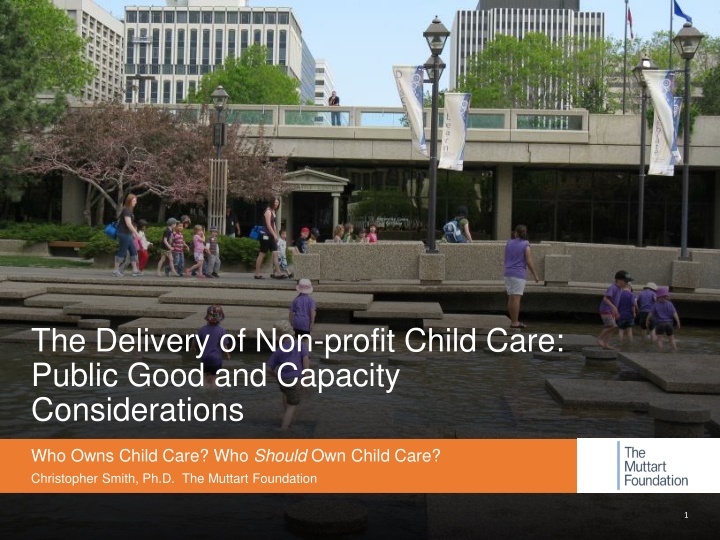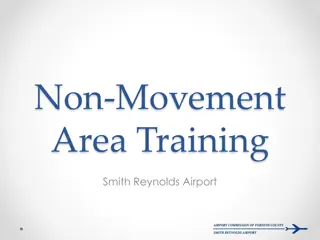
Non-Profit Child Care Delivery: Ownership and Benefits Explained
Discover the significance of non-profit child care ownership, the benefits of high-quality early learning programs, and the role of charities in the Canadian child care sector. Explore the public good aspect of early childhood services and the various non-profit organizational types contributing to child care provision.
Download Presentation

Please find below an Image/Link to download the presentation.
The content on the website is provided AS IS for your information and personal use only. It may not be sold, licensed, or shared on other websites without obtaining consent from the author. If you encounter any issues during the download, it is possible that the publisher has removed the file from their server.
You are allowed to download the files provided on this website for personal or commercial use, subject to the condition that they are used lawfully. All files are the property of their respective owners.
The content on the website is provided AS IS for your information and personal use only. It may not be sold, licensed, or shared on other websites without obtaining consent from the author.
E N D
Presentation Transcript
The Delivery of Non-profit Child Care: Public Good and Capacity Considerations Who Owns Child Care? Who Should Own Child Care? Christopher Smith, Ph.D. The Muttart Foundation 1
A New vision for ELCC in Canada: Canada-wide agreements Federal Budget 2021 - commitment to work collaboratively with provincial and territorial governments to build a Pan-Canadian ELCC system The transformation of ELCC sectors into ELCC systems New federal investments of $27.2 billion over five years for provincial and territorial system building - a further $2.5 billion for Indigenous ELCC Commitments to affordability, the expansion of services, inclusion and quality Commitment to the creation of more high-quality, affordable regulated spaces, primarily through not-for-profit and public child care providers Variations of this wording in individual agreements 2
The Benefits of High-Quality Early Learning and Child Care Provision High-quality, affordable child care can help advance a number of related public benefits Children s early childhood development and growth The labour force participation of parents of young children economic well-being Advancing gender equity and inclusion Support for social solidarity and the building of community Realizing these benefits depends on how ELCC services are organized, financed and delivered recognition of ELCC as a public good rather than a private market-based service 3
Non-Profit Early Learning and Child Care Delivery the Role of Registered Charities Across Canada, Canadian Charities play a vital role in the delivery of child care Charities role in ELCC flows from the traditions that underpin the charitable and voluntary sector A tradition of voluntary actions and association and a focus on public benefit A tradition of delivering services which support government public policy goals Charities must pursue purposes that are charitable and which advance public benefit Governance and engagement of communities, ownership and use of resources and assets for public good Different types of non-profit organizations why this matters for ELCC Community-based non-profit organizations (may be eligible for charitable registration) Co-operatives organized for the benefit/need of members jointly owned enterprises Non-profit private company formed to promote beneficial purposes other than monetary gain 4
Non-Profit ELCC Services in Saskatchewan and Alberta Saskatchewan ELCC Sector Non-profit providers comprise the vast majority of the centre-based sector Non-profit child care centres must have a board of directors, majority of whom are parents of children enrolled in the centre (requirement may be waived) Limits on size of centres (up to 90 children) For-profit centres not eligible for public funding Alberta ELCC Sector Non-profit providers comprise approximately 40 percent of centre-based services Non-profit and for-profit centre-based services eligible for same public funding Proposed Expansion of ELCC Services under Canada-Wide Agreements Saskatchewan expansion in non-profit centre-based services and family child care Alberta expansion in both non-profit and for-profit centred based services and family child care 5
Matters for Consideration in Non-profit ELCC Service Delivery in Saskatchewan and Alberta Capacity of non-profit service providers to expand services Access to capital Access to infrastructure, expertise and workforce Local mandate and focus (community-based) Public planning and management of ELCC as a public good Services publicly managed and planned to meet children s and families needs ELCC services responsive to community needs and actively engage stakeholders Public funding, infrastructure and resources support the design and delivery of services that meet public policy goals 6
Non-Profit Child Care Delivery Public Benefit and Capacity Considerations Thank you . . . . Your comments and questions 7






















